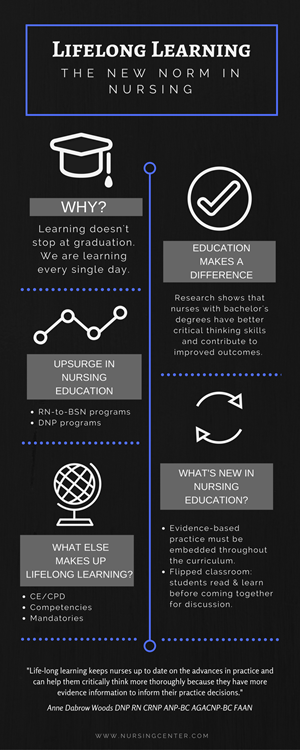 If you’ve been thinking about continuing your education, you’ll find many of your colleagues are too. This article talks about the importance and trend to keep learning in the Nursing field.
If you’ve been thinking about continuing your education, you’ll find many of your colleagues are too. This article talks about the importance and trend to keep learning in the Nursing field. Turns out, the way students are being taught is changing and it may be different than how you were taught years ago. Read on to learn more.
With the end of 2016 quickly approaching, it’s important to look ahead to the future trends happening in the nursing profession. More and more, nurses are going back to school to earn higher degrees, but why? "Life-long learning keeps nurses up-to-date on the advances in practice and can help them critically think more thoroughly because they have more evidence and information to inform their practice decisions,” explains our Chief Nurse, Anne Dabrow Woods DNP RN CRNP ANP-BC AGACNP-BC FAAN.
Whether you’re a nurse with a diploma or associate’s degree contemplating achieving your BSN, or you’re looking to pursue an advanced degree in nursing, you’re not alone. According to a 2014 survey by the American Association of Colleges of Nursing (AACN), there’s been a “4.2% increase in students in entry-level baccalaureate programs (BSN) and a 10.4% increase in ‘RN-to-BSN’ programs for registered nurses looking to build on their initial education at the associate degree or diploma level. In graduate schools, student enrollment increased by 6.6% in master’s programs and by 3.2% and 26.2% in research-focused and practice-focused doctoral programs, respectively.”
With this new shift to lifelong learning in nursing, educators are adapting the way to they teach their students. “When we were [originally] taught how to educate students,” Woods says, “we were taught to sit them in a classroom and to lecture to them. That is not reality anymore today. What we’ve seen is a whole flip of the classroom so that the students or nurses…read, learn, and then come together and they discuss how to actually apply the principles that they’ve learned. That’s called the ‘flipped classroom,’ and that is what we are going to be using from now on.”
To discover more about the flipped classroom and other changes in lifelong learning in nursing, utilize this handy infographic.

If you have any questions regarding this article or anything else, feel free to ask one of our Nurse Leaders by clicking below!








